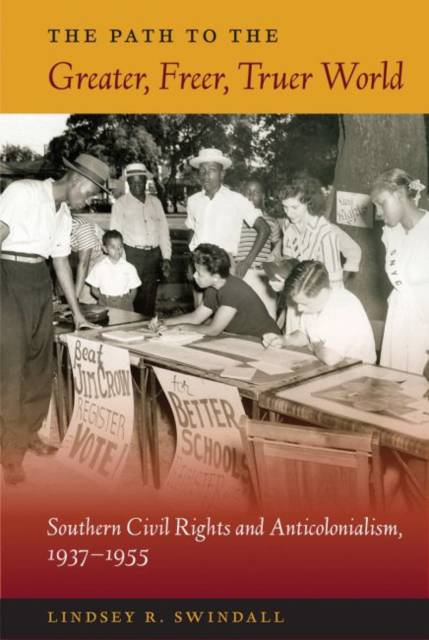
- Afhalen na 1 uur in een winkel met voorraad
- Gratis thuislevering in België vanaf € 30
- Ruim aanbod met 7 miljoen producten
- Afhalen na 1 uur in een winkel met voorraad
- Gratis thuislevering in België vanaf € 30
- Ruim aanbod met 7 miljoen producten
Zoeken
The Path to the Greater, Freer, Truer World
Southern Civil Rights and Anticolonialism, 1937-1955
Lindsey R Swindall
€ 38,45
+ 76 punten
Uitvoering
Omschrijving
The Southern Negro Youth Congress and the Council on African Affairs were two organizations created as part of the early civil rights efforts to address race and labor issues during the Great Depression. They fought within a leftist, Pan-African framework against disenfranchisement, segregation, labor exploitation, and colonialism. By situating the development of the SNYC and the Council on African Affairs within the scope of the long civil rights movement, Lindsey Swindall reveals how these groups conceptualized the U.S. South as being central to their vision of a global African diaspora. Both organizations illustrate well the progressive collaborations that maintained an international awareness during World War II. Cleavages from anti-radical repression in the postwar years are also evident in the dismantling of these groups when they became casualties of the early Cold War. By highlighting the cooperation that occurred between progressive activists from the Popular Front to the 1960s, Swindall adds to our understanding of the intergenerational nature of civil rights and anticolonial organizing. A volume in the series New Perspectives on the History of the South, edited by John David Smith
Specificaties
Betrokkenen
- Auteur(s):
- Uitgeverij:
Inhoud
- Aantal bladzijden:
- 254
- Taal:
- Engels
- Reeks:
Eigenschappen
- Productcode (EAN):
- 9780813056340
- Verschijningsdatum:
- 14/05/2019
- Uitvoering:
- Paperback
- Formaat:
- Trade paperback (VS)
- Afmetingen:
- 152 mm x 229 mm
- Gewicht:
- 376 g

Alleen bij Standaard Boekhandel
+ 76 punten op je klantenkaart van Standaard Boekhandel
Beoordelingen
We publiceren alleen reviews die voldoen aan de voorwaarden voor reviews. Bekijk onze voorwaarden voor reviews.











